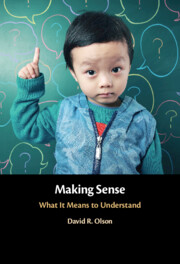Book contents
- Making Sense
- Making Sense
- Copyright page
- Dedication
- Contents
- Figures
- Tables
- Preface
- 1 An Introduction to the Puzzles of Understanding
- 2 Understanding As Feeling and As a Concept
- 3 The Linguistic Basis of Mind
- 4 Subjective Mental States
- 5 Objective Mental States
- 6 Intersubjectivity of Mental States
- 7 Identity Conditions for Feelings and Concepts
- 8 What “Understanding” Means
- 9 The Referential Scope of Understanding
- 10 Understanding and Children’s Theory of Mind
- 11 Understanding and Sense-Making
- 12 Understanding As a Learnable Skill
- 13 Understanding in Everyday Life
- 14 Ascriptivism and Cognitive Development
- References
- Index
3 - The Linguistic Basis of Mind
Published online by Cambridge University Press: 21 April 2022
- Making Sense
- Making Sense
- Copyright page
- Dedication
- Contents
- Figures
- Tables
- Preface
- 1 An Introduction to the Puzzles of Understanding
- 2 Understanding As Feeling and As a Concept
- 3 The Linguistic Basis of Mind
- 4 Subjective Mental States
- 5 Objective Mental States
- 6 Intersubjectivity of Mental States
- 7 Identity Conditions for Feelings and Concepts
- 8 What “Understanding” Means
- 9 The Referential Scope of Understanding
- 10 Understanding and Children’s Theory of Mind
- 11 Understanding and Sense-Making
- 12 Understanding As a Learnable Skill
- 13 Understanding in Everyday Life
- 14 Ascriptivism and Cognitive Development
- References
- Index
Summary
Modern linguists, like the hermeneuticists before them, insist that language is an autonomous, self-contained system, a module, in which components, whether phonological, semantic, or grammatical, are represented in terms of each other – /b/ differs from /p/ by a single feature “voiced”; bachelor differs from male adult by the feature “married,” and so on (Jackendoff, 2002). As Saussure (1958) put it, “In language there are only differences.” Although, in humans, learning a language appears to also depend on knowledge of the world of reference, what is learned is a language, “an autonomous system existing in the mind” (Katz & Fodor, 1963). These linguistic structures – technically “semantic structures” or Fregean senses, are the meanings in the language that exist quite independently of the ways that those semantic structures refer to the world. Thus, senses are not merely signs; they are meanings defined in terms of each other – dog as an animal, green as a color, up as opposed to down, and so on.
Information
- Type
- Chapter
- Information
- Making SenseWhat It Means to Understand, pp. 31 - 39Publisher: Cambridge University PressPrint publication year: 2022
